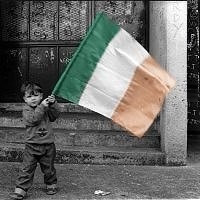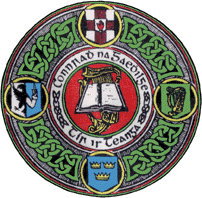![]() A Brief Modern History of Irish Dance
A Brief Modern History of Irish Dance
 The Gaelic League was founded in 1893 to advocate "'the regeneration of the contemporary nation... by a return to its creative source in evolving Gaelic civilization of its recent past'." The League's overall goal was to "de-Anglicise" Ireland, and to do so, they stressed a revival of the Gaelic language, dress, dance, and custom. In the late 1800's, emigration from Ireland due to famine and oppression was at its peak, and overall Irish morale was low. The forming of the Gaelic League, in part, helped to revive a nationalistic feeling in Irish people, and slow emigration. The leaders of the Gaelic League were educated people: poets, writers, artists, historians and philosophers. These people knew of and associated with other educated elite of the time who saw a deep need and necessity for a culture to have its own identity. The consequence: Conradh na Gaeilge [see logo below]. The League saw Irish language (Gaelic) as the key to maintaining Irish heritage/identity. The conversion to the English language not only assimilated Irishmen into another culture, but an entirely different form of cognition and knowledge. The Irish language
The Gaelic League was founded in 1893 to advocate "'the regeneration of the contemporary nation... by a return to its creative source in evolving Gaelic civilization of its recent past'." The League's overall goal was to "de-Anglicise" Ireland, and to do so, they stressed a revival of the Gaelic language, dress, dance, and custom. In the late 1800's, emigration from Ireland due to famine and oppression was at its peak, and overall Irish morale was low. The forming of the Gaelic League, in part, helped to revive a nationalistic feeling in Irish people, and slow emigration. The leaders of the Gaelic League were educated people: poets, writers, artists, historians and philosophers. These people knew of and associated with other educated elite of the time who saw a deep need and necessity for a culture to have its own identity. The consequence: Conradh na Gaeilge [see logo below]. The League saw Irish language (Gaelic) as the key to maintaining Irish heritage/identity. The conversion to the English language not only assimilated Irishmen into another culture, but an entirely different form of cognition and knowledge. The Irish language  differs from the English language greatly enough that the change from one to another is a change in a person's entire realm of thinking. To avoid this, the league instituted Gaelic schools, which taught Gaelic customs and language, as well as feisana (a.k.a.: "feisanna" or "feisianna": "festival"). Feisana were community festivals with singing, dancing, storytelling, and sports. Most importantly, they were arenas for the conversation in the Irish language. Dancing, because of its popularity in the feisana, soon became a tool to draw people to general meetings for the League. It was discovered that dancing was more of an appeal than promises of intellectual debates and political verbosity. With the takeover of the Gaelic League by the militaristic Sinn Fein (pronounced "shin fine," meaning "ourselves alone") in 1903, social dances and feisana became a way to raise money for military activities. Dance quite literally became the gunpowder for the Irish Revolution. The League then developed the scoil rince (dancing school) in 1915 for the preservation, promotion and "nationalistic cleansing" of traditional Irish dance. Along with the scoil rince, in 1929 it came the development of An Coimisiun le Rinci Gaelacha (The Irish Dancing Commission). This commission was created by the League to monitor and control the practice, teaching and performing of Irish dance. Even today, it is impossible to legitimately teach, dance, perform or judge Irish dance without permission from An Coimisiun. The goals of An Coimisiun were (and still are): a) do everything necessary to promote Irish dancing, both ceili and step, b) exercise control on Irish dancing and those connected with it: teachers, pupils, adjudicators and organizers of feisana, c) draw up all rules necessary for those purposes and enforce the implementation of those rules. Irish dancing has now moved from a tool of an aspiring cultural confederacy to an individual and recognized art form. During the 20th Century, Irish dance has evolved in terms of locations, costumes and dance technique. For example, during the period of the dance masters, stages were much smaller including table tops, half doors, and sometimes the "stage" was simply a crossroad. Tests of dancing ability involved dancing on the top of a barrel or on a soaped table! As stages became larger, the dance changed in at least two ways. The movement of dancers across a stage increased greatly (a judge would now subtract points if a dancer did not "use the stage") and dance steps that require substantial space became possible (e.g., "flying jumps"). The location of competitions also changed over time from barns or outdoors where flat bed trucks were (and still are) used as stages, to predominately indoors in hotels, schools or fairgrounds.
differs from the English language greatly enough that the change from one to another is a change in a person's entire realm of thinking. To avoid this, the league instituted Gaelic schools, which taught Gaelic customs and language, as well as feisana (a.k.a.: "feisanna" or "feisianna": "festival"). Feisana were community festivals with singing, dancing, storytelling, and sports. Most importantly, they were arenas for the conversation in the Irish language. Dancing, because of its popularity in the feisana, soon became a tool to draw people to general meetings for the League. It was discovered that dancing was more of an appeal than promises of intellectual debates and political verbosity. With the takeover of the Gaelic League by the militaristic Sinn Fein (pronounced "shin fine," meaning "ourselves alone") in 1903, social dances and feisana became a way to raise money for military activities. Dance quite literally became the gunpowder for the Irish Revolution. The League then developed the scoil rince (dancing school) in 1915 for the preservation, promotion and "nationalistic cleansing" of traditional Irish dance. Along with the scoil rince, in 1929 it came the development of An Coimisiun le Rinci Gaelacha (The Irish Dancing Commission). This commission was created by the League to monitor and control the practice, teaching and performing of Irish dance. Even today, it is impossible to legitimately teach, dance, perform or judge Irish dance without permission from An Coimisiun. The goals of An Coimisiun were (and still are): a) do everything necessary to promote Irish dancing, both ceili and step, b) exercise control on Irish dancing and those connected with it: teachers, pupils, adjudicators and organizers of feisana, c) draw up all rules necessary for those purposes and enforce the implementation of those rules. Irish dancing has now moved from a tool of an aspiring cultural confederacy to an individual and recognized art form. During the 20th Century, Irish dance has evolved in terms of locations, costumes and dance technique. For example, during the period of the dance masters, stages were much smaller including table tops, half doors, and sometimes the "stage" was simply a crossroad. Tests of dancing ability involved dancing on the top of a barrel or on a soaped table! As stages became larger, the dance changed in at least two ways. The movement of dancers across a stage increased greatly (a judge would now subtract points if a dancer did not "use the stage") and dance steps that require substantial space became possible (e.g., "flying jumps"). The location of competitions also changed over time from barns or outdoors where flat bed trucks were (and still are) used as stages, to predominately indoors in hotels, schools or fairgrounds.
![]()